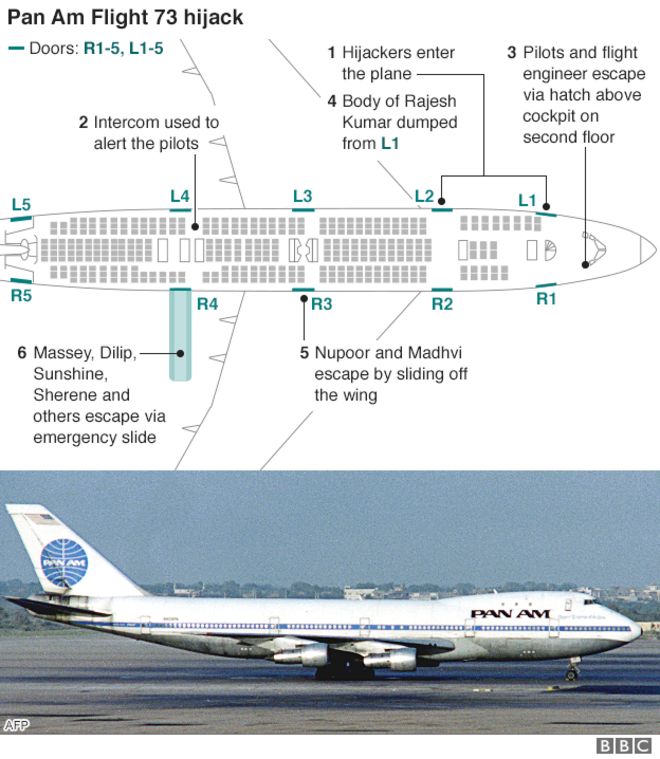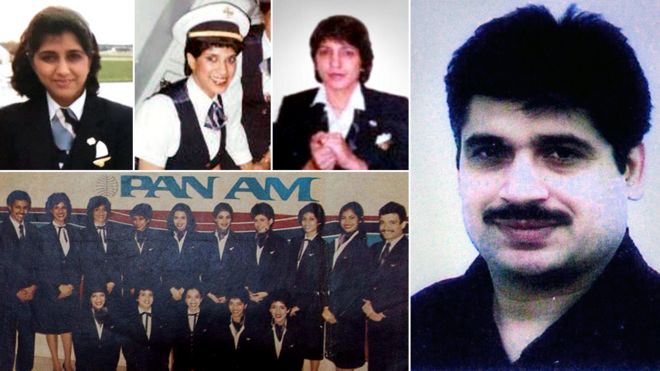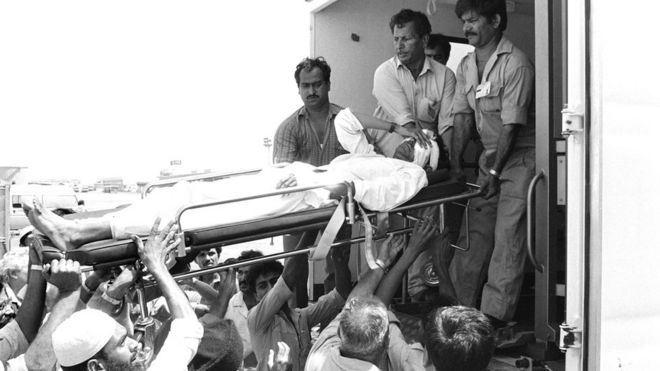- 31 March 2016
- Asia
-
(아시아) 1986년도 납치되었던 판암 73기에 관한 새로운 이야기국제문제/아시아 2016. 4. 1. 19:55
출처: http://www.bbc.com/news/world-asia-35800683
Inside a hijack: The unheard stories of the Pan Am 73 crew
 Pan Am Crew Facebook Page
Pan Am Crew Facebook PageThe crew of Pan Am Flight 73 (three of whom are pictured here with their colleagues) were all in their early to mid 20s at the time of the hijack. Nearly 30 years after the hijack of Pan Am Flight 73 at Karachi airport, six of the plane's crew have spoken to the media for the first time.
"My first instinct was to open the wing exit and slip out with as many passengers as I could, but I realised that this would leave the rest of the passengers vulnerable," then flight attendant Nupoor Abrol told BBC News.
Security forces laid siege to the New York-bound plane for 16 hours at Karachi airport after the jet was taken over by Palestinian militants on 5 September 1986. There was a bloody end - 22 people killed and about 150 injured.
It shocked the world, and is the subject of a newly released film, but the surviving crew have until now remained silent.
While they relayed the events to a private FBI meeting a week after the hijack, and to a parole hearing for the lead hijacker in 2005, this is the first time they have shared details with the media. They also shed light on the last few hours of Neerja Bhanot, their colleague who died in the attack and is the subject of the new film.
They are breaking this silence now, they say, because they want to honour and acknowledge the vital roles played by all on board, most of whom are not known to the public.
"The hijack is far from over for me and my colleagues. Some of us, passengers and crew alike, are still struggling with the skeletons of the past, trying to fix the puzzle of incidents, sequences, people who were involved in the chains of events," says Nupoor.
"The stories may differ but the spirit remains the same."
Gunmen enter the plane

It was just before 06:00 and Pan Am Flight 73, on a stopover in Karachi from Mumbai, was scheduled to continue on to Frankfurt, en route to New York. There were 14 flight attendants on board, 12 of whom were preparing for take-off.
Outside, four gunmen had sped on to the tarmac in a van disguised as airport security. The men entered the Boeing 747, firing shots into the air.
Nupoor saw them shoot near the feet of a colleague, shouting at her to lock the door.
Flight attendant Sherene Pavan, who was out of sight of the militants, heard the commotion, reached for the intercom and pressed the emergency number to the cockpit. The pilot picked up on her second attempt and she relayed the hijack code.
Fellow attendant Sunshine Vesuwala saw one of the hijackers grab a colleague, Neerja Bhanot, and put a gun to her head.
And then another militant, his AK-47 and grenades in clear view, instructed Sunshine to take him to the captain.
The disappeared pilots
The cockpit was empty.
"I noticed immediately that the escape devices in the cockpit had been deployed. I noticed that the evacuation hatch on the ceiling of the cockpit was open, but I pretended not to. I wanted to give the pilots time to escape in case they were still in the process of climbing down the ropes outside the plane. The hijacker didn't seem to know much about the plane so he didn't look for it," says Sunshine.
 .
.(From top left): Nupoor, Sunshine, Sherene, Dilip. (In group shot - far left): Massey. (Credits: Solo shots - individuals' own; group shot: Pan Am crew Facebook page)  .
.The crew now: (From top left to bottom right), all credits to the individuals) Sherene, Massey, Madhvi, Sunshine, Dilip, Nupoor "Many have criticised the pilots for leaving the rest of the crew behind, but I was relieved when I saw the pilots were gone, as we were all safer on the ground than we would be in the air. And in any case, at least the three pilots were safe. Three lives would be saved."
Dilip Bidichandani, another steward, is adamant that the pilots' escape actually saved more lives.
"The pilots evacuating the airplane… meant that we were not at the mercy of the terrorists, who could have instructed the plane to be flown into a building, or even blown up whilst in flight."
The gunmen's plan was to force the pilots to fly them to Cyprus and Israel, where other members of their militant group were incarcerated on terror charges.
Outside on the tarmac, Pan Am's Karachi director Viraf Doroga used a megaphone to begin negotiations with the hijackers. He told the four men that the airport authorities were looking for pilots to fly them where they needed to go.
Meanwhile, inside the plane, 29-year-old American passenger Rajesh Kumar was pulled out of his seat and made to kneel in front of one of the open doors, with a gun to his head. When no pilot materialised within the hour, Mr Kumar was shot and kicked out of the plane.
"This changed everything. It showed they were ruthless killers," says Sunshine.
Looking for Americans
Around four hours into the siege, the hijackers began trying to identify the Americans on board. The Abu Nidal Organisation (ANO), which they were members of, was opposed to US and Israeli policy in the Middle East.
 Mike Thexton
Mike ThextonPassenger Mike Thexton has praised the flight attendants' bravery Sunshine, Madhvi Bahuguna and another flight attendant began collecting passports, quietly avoiding collecting any that were American.
They then went through the bags of passports they had collected, secretly sifting out any remaining American ones and tucking them under their seats or concealing them in their clothing.
Mike Thexton, a passenger on the plane, describes the act in his book What Happened to The Hippy Man? as "extremely brave, selfless and clever".
"I may be biased but I feel that day proved that the flight attendants on board were some of the best in the industry."
Having failed to find an American, the militants settled for someone British. Mike was made to sit on the floor, and like the other passengers, keep his hands above his head. Aside from one sharp kick, he says, he was not physically mistreated and eventually escaped with others in the later chaos.
Human shields
Sherene and Sunshine were the cabin crew who spent the most time with lead hijacker Zaid Hassan Abd Latif Safarini. He repeatedly led either Sunshine or Sherene at gunpoint up to the upper deck cockpit, using them as human shields while he peeked round them to have a look outside.
on occasion he would hold my hair, force my face to the window and ask what I could see on the tarmac. He said he was looking for American fighter planes," says Sherene.
The Pan Am hijackers
- The Abu Nidal Organisation (ANO) is a Palestinian militant group, now considered largely inactive. Also known as Fatah-The Revolutionary Council, it is listed as a terrorist group by the United States, Israel and the European Union. It was blamed for a string of attacks in the 1970s and 80s, killing and wounding hundreds of people
- The Pan Am crew were recognised with courage awards by the airline in 1986, the US Department of Justice in 2005 and the US attorney general in 2006. Neerja Bhanot was the only crew member to be awarded posthumous bravery awards by India and Pakistan
- The Pakistani authorities released the leader of the hijackers, Zaid Hassan Abd Latif Safarini, in September 2001, but he was quickly recaptured by the US
- Safarini is 12 years into his 160-year sentence in a US prison. The other hijackers were released from their Pakistani jail in 2008, against the wishes of India and the US
Meherjee Kharas, a 28-year-old Pan Am mechanic on board, was forced to make radio contact with negotiators outside. At this stage the hijackers still believed a pilot would be found to fly the plane for them.
Over the next few hours on the upper deck, Safarini let his guard down several times, Sunshine says. He joked and flirted, invited her to go with him to Cyprus, and promised to teach her to swim.
Sunshine remained alert. At one point she looked longingly at the emergency axe in a glass box in the cockpit. Safarini, mid-joke, caught her and immediately pointed the gun at her head.
"Don't even think about it," he said.
Eventually the militants threatened that, as a pilot had not materialised, a passenger would be shot every 15 minutes.
Nupoor tried to comfort the passengers around her while her colleague Dilip Bidichandani took round sandwiches and Neerja distributed water.
"That day, knowingly or unknowingly, we came together as a team and played our parts to the best of our ability," says Massey Casper, another steward.
Although the hijackers had closed the doors and lowered the shutters earlier, the air conditioning and lights had been on. As evening set in, the on-board power supply started to dwindle, the lights got dimmer and the cool air stopped circulating.
Moments until darkness
Meherjee, the mechanic, told Safarini that the emergency power would last 15 minutes or so before the aircraft would be plunged into darkness. Sherene says she knew then that time was running out.
 AP
APA film has recently been released about Neerja Bhanot, who was fatally injured in the hijack When the lights did go out, all the flight attendants and passengers were in the middle section of the cabin, several seated on the ground in the aisles and near the doors. The gunmen positioned themselves on either side of the aisles.
"They had lost patience. They let out a war cry," says Sunshine, "and began firing into the crowd. There were huge streaks of light breaking the darkness. And screams."
Sherene saw that mechanic Meherjee had been killed.
In the chaos and darkness, at least three doors had been opened, though it is not clear by whom. The door nearest the wing had been opened in manual, which meant that the emergency slide did not deploy. It was a short jump to reach the wing of the plane. Many went for it. Nupoor and Madhvi slipped off the edge of the wing, fracturing bones as they hit the tarmac around 20 feet (6 metres) below.
Sunshine and Dilip were also on the wing, but in the darkness couldn't gauge the distance of the drop. They saw another door had been deployed in automatic, which meant that the emergency slide was inflated.
They climbed back in through the door they had come through, and along with Sherene and another colleague, assisted and redirected passengers to the inflated slide.
Massey had already exited down the slide just moments earlier, taking three unaccompanied children with him.
Then, when all the passengers were off the wing, the crew did something remarkable. Not hearing any more gunfire, but not knowing where the gunmen were, they went back into the dark plane to look for survivors.
Neerja shot
That's when Sunshine saw Neerja.
Neerja had been shot in her hip and was bleeding heavily, but was conscious. Sunshine called Dilip over to help, and the two carried Neerja to the emergency slide. They pushed her down first, then jumped out themselves.
 AFP
AFPAbout 150 people were injured Sherene, and another colleague Ranee Vaswani, were the last two hostages to leave the plane. Three of the hijackers were fleeing the airport when they were caught by airport security. Safarini was still on board when Pakistan's security forces entered the plane.
Neerja's colleagues say she was still alive when she arrived at Karachi's Jinnah Hospital.
"It was chaotic, like a war zone, in there. Neerja may still be alive if she'd been cared for right away," says Sunshine.
"I didn't see medical facilities at the airport besides minor first aid… The hospital was several kilometres away from the airport," says Dilip. "Neerja was put into the ambulance without a stretcher."
Once they finally got to the hospital, the chaos continued, Sherene says.
"Neerja's life may have been saved were conditions in the hospital better."
Return to Pan Am
After a short break all the Flight 73 crew returned to Pan Am for at least a few years.
They occasionally worked the same flight and ran into each other at layovers. They didn't discuss the hijack.
All have coped in different ways. Two of the six remain in the industry.
During their interviews with the BBC, they stressed that there was no single hero that day, that crew members not interviewed played an equally important role, and that they want survivors of terror attacks like 9/11 and Paris to know that life goes on.
They also want people to know they dearly miss their colleagues Neerja Bhanot and Meherjee Kharas.
"Survivors [of such atrocities] are living each day with the memories," says Madhvi. She hopes that, in speaking out, "we can all connect through our survival stories and form a fabric of power and strength going forward".
'국제문제 > 아시아' 카테고리의 다른 글
(아시아) 한국 총선 새누리 기존 위치 고수 희망 (0) 2016.04.13 (아시아) 모델 선발대회에서 실수한 한국 참가자에게 화를 낸 사건에 팬들 흥분 (0) 2016.04.01 (아시아/미안마) 미안마 라킨州: 미안마에서 시끄러운 州 (0) 2016.03.30 (아시아/미안마) 미안마 집단폭동 후 4년간 지속되었던 라킨州 비상사태 해제 (0) 2016.03.30 (아시아) 한국 군대 로맨스 드라마 <태양의 후예> 아시아를 휩쓸다 (0) 2016.03.28